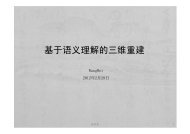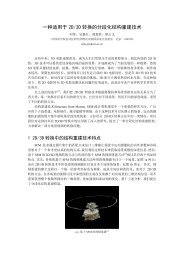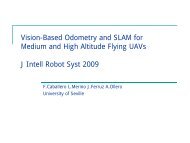Rotationally Invariant Descriptors using Intensity Order ... - IEEE Xplore
Rotationally Invariant Descriptors using Intensity Order ... - IEEE Xplore
Rotationally Invariant Descriptors using Intensity Order ... - IEEE Xplore
You also want an ePaper? Increase the reach of your titles
YUMPU automatically turns print PDFs into web optimized ePapers that Google loves.
This article has been accepted for publication in a future issue of this journal, but has not been fully edited. Content may change prior to final publication.<br />
<strong>IEEE</strong> TRANSACTION ON PATTERN ANALYSIS AND MACHINE INTELLIGENCE 12<br />
Eq. (2) and Eq. (3), we have<br />
X = 1 1<br />
A− 2 X<br />
r ′ = T −1 X ′<br />
Therefore, for each sample point X ′ in the normalized region, we calculate its corresponding<br />
point X in the detected region and take the intensity of X as the intensity of X ′ in the normalized<br />
region, i.e., I(X ′ )=I(X). Usually, X is not exactly located at a grid point, so I(X) is obtained<br />
by bilinear interpolation. Fig. 4 gives an example of the normalized region.<br />
Fig. 4. The affine normalization of a detected region to<br />
the canonical circular region (normalized region).<br />
(4)<br />
Fig. 5. The locally rotation invariant coordinate system used for<br />
calculating local feature of a sample point Xi. P is the interest<br />
point (center of the normalized region).<br />
In the reminder of this paper, support regions are such normalized circular regions and<br />
intensities of points in the support regions are obtained by bilinear interpolation as described<br />
above.<br />
B. Support Region Partition Based on <strong>Intensity</strong> <strong>Order</strong>s<br />
Given a support region, one can divide it into several rings and pool together the calculated<br />
local features of sample points in each ring in a similar way as spin image or RIFT [10] does, so as<br />
to achieve a rotation invariant description of the region. However, such an undertaking will reduce<br />
the distinctiveness of descriptor since some spatial information is lost. In other words, pooling<br />
local features circularly achieves a rotation invariant representation at the expense of descriptor’s<br />
discriminative ability degradation. Therefore, many popular and state-of-the-art methods divide<br />
the support region into subregions in order to encode more spatial information, such as SIFT [6],<br />
DAISY [16], CS-LBP [14], OSID [28] and so on [15], [27], [29]. Unfortunately, these pre-defined<br />
subregions need to assign a reference orientation in order to be rotation invariant. As we analyzed<br />
in Section III, the orientation estimation is not stable enough, and we adopt here a different<br />
November 26, 2011 DRAFT



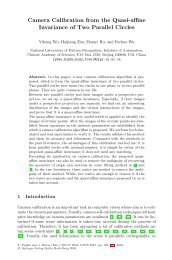
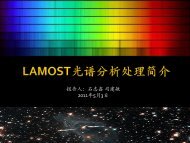
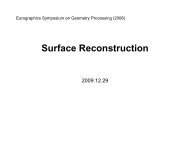
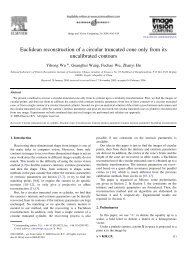
![Accurate, Dense, and Robust Multi-View Stereopsis (PMVS) [1,2,3]](https://img.yumpu.com/19388840/1/190x135/accurate-dense-and-robust-multi-view-stereopsis-pmvs-123.jpg?quality=85)



